
This is the dawn of the golden age for marketers on LinkedIn
Social media has changed marketing for good. According to recent research from We Are Social, there are 3.8 billion people actively using social media, and if that’s where the market is, that’s where the marketers will focus their efforts.
When we think of promoting our content, products, services on social media, which platforms spring to mind? Instagram, Facebook, Twitter, no doubt, because that’s where the biggest audiences are, right? Facebook, the biggest of all social media sites, boasts an impressive 2.45 billion monthly active users.
So, what about LinkedIn? LinkedIn is a rapidly growing and fast-changing platform, and as of February this year, the site has a user base that is 675 million strong. Of those, 310 million are active monthly users, and 40% log in at least once a day. That’s no small audience.
LinkedIn has seen continuous growth and development over the past few years, with the platform changing significantly, too. From the types of content you’ll find in your feed now to the ever-changing algorithm, LinkedIn has come a long way since its days as the resume hosting site it was known as some 4-5 years ago.
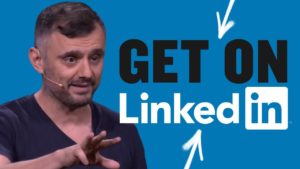
Gary Vaynerchuk spoke on the state of LinkedIn marketing in 2020 (image source)
Why LinkedIn? Well, in short, LinkedIn isn’t the only social media platform that’s come a long way. It’s just that it’s less professional-focused counterparts are changing for the worst for marketers. As mainstream social media networks like Instagram and Facebook grew, the sites made it increasingly hard to reach an audience organically. Seemingly, the only way to get your post to reach your entire earned audience would be to pay to boost your posts. Paying for advertising on social media is a small fee for some organizations, but it’s leaving a bad taste in the mouths of marketers as the decline in organic reach seems only to be getting worse.
“LinkedIn is going through a Facebook 2012 moment” – Gary Vaynerchuk, January 2020
Although it’s changing algorithms that are making it harder for businesses to cut through the noise, LinkedIn’s potential for organic reach is unquestionable, and its heyday is now. Here are a few ways your brand can capitalize on this golden age of LinkedIn.
Jump to:
- Know What Content Performs Best
- Post Company Culture Content
- Create Original Video Content
- Utilize Employee Advocates
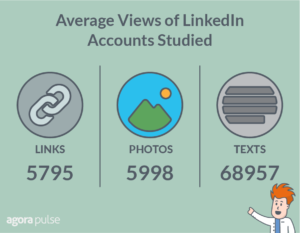
Agorapulse tested three types of content to see which would perform the best (© Agorapulse image source)
Know What Content Performs Best
Even though LinkedIn’s organic reach and post visibility are higher than other social media sites, its algorithm can still be harsh. There’s no doubt that some forms of content will perform particularly well compared to others, and you’ll have likely noticed this already.
A recent study from Agorapulse measured the performance of three types of content on LinkedIn. Those were; photo content, link sharing, and text-only posts. The study measured page views per piece if content, in a bid to understand which content form the algorithm favors.
The results were surprising, as the study saw the text-only post generate more than 10x the page views than both the photo content and link-sharing content (68,957 page views compared to photo, which took second place with 5998 page views).
This is not the only experiment to show similar results, as Social Media Today conducted a similar test that saw text-only posts score similarly to those in the Agorapulse study. The text-only posts outperformed those with links by ten-fold.
So, how best to write your text-only posts?
Firstly, lead with a great opening sentence. At 140+ characters, LinkedIn will shorten your post and offer users the chance to read on with a “see more” function, so make sure your opener is a hook! Secondly, focus on storytelling where possible.
As LinkedIn becomes more “2012 Facebook,” users are craving authenticity and stories from brands, so take this opportunity to be a little more human.
Lastly, always add value. Why should a reader keep reading? What will they gain from reading your post? Is it knowledge or inspiration? Don’t just post for the sake of posting, ensure that what your brand posts is inspired and fulfills its purpose.
Top tip: If you’ve got a particular piece of content that you want to share, post your caption and add the link in the comments. Just remember to tell your audience that you’ve left it there!
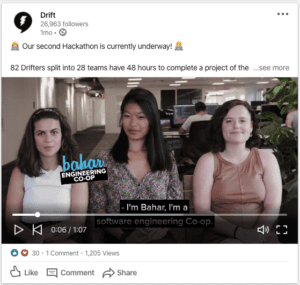
Drift has long championed the idea of putting people at the forefront of their brand
Post Company Culture Content
The organic reach isn’t the only similarity between LinkedIn in 2020 and Facebook in 2012. LinkedIn, as a platform, has become much more people-focused in recent years, with companies and professionals alike using the site as an outlet to develop their brands.
LinkedIn hosts 657 million users, and 50% of those have a college degree. In other words, the site hosts a pool of qualified professionals and potential top candidates. So use the site as a means of showcasing your company culture.
It’s no secret that these candidates will do their research on your company before they consider you as an employer, using sites such as Glassdoor and Fairygodboss, and, more importantly, your company’s social media.
So, when they look, what will they see? Will they see staged stock photography and masses of corporate content, or will they get a genuine look at what life at your company is really like. Posting content that showcases company culture puts the power back into the hands of you, the brand, allowing you to control the narrative.
Company culture content can be anything from a photo welcoming a new recruit to videos of company events or award ceremonies.
Look no further than Boston-based sales and marketing company, Drift, for examples of best practice in showcasing company culture!
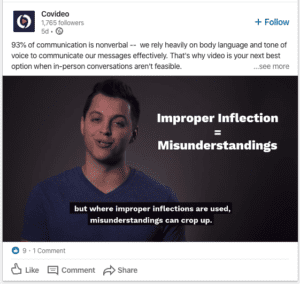
Covideo offers a fantastic function that allows users to seamlessly add captions to their videos.
Create Original Video Content
Though this somewhat contradicts the previous sentiment regarding all-text posts being the most effective way of beating LinkedIn’s algorithm, it’s no secret that in 2020, visual content is king.
So, why is video so popular? And why does it perform so well? In a word: accessibility. If you go the extra mile in the creation process, adding subtitles and captions, then your videos can be watched just about anywhere. Whether it’s a commuter on a train or an employee who perhaps shouldn’t be watching videos, captions allow people to watch and learn without even having to switch on audio. Video provides versatility and is becoming ever more sought after for potential buyers to learn more about a brand’s product and services.
There are still methods to optimize your video content to beat the algorithm, as native videos will rank significantly higher than external videos, such as Vimeo links. The external link can downgrade your post and reduce its visibility.
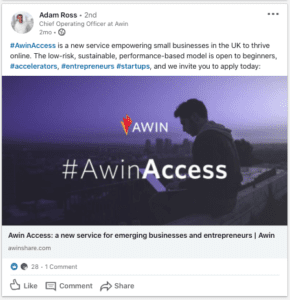
Having employees advocating for your organization is a more authentic way of promoting your content.
Utilize Your Employee Advocates
Leveraging the power of your employees’ networks on LinkedIn is a fantastic way to boost the organic reach of your content while increasing engagement and generating website traffic. Employee advocacy can even be used as a means of spotlighting your company’s LinkedIn page.
Employee advocacy, in its purest form, is the promotion of an organization and its products or services by one of its employees—an effortless and staggeringly effective practice used by some of the biggest brands globally.
The theory of employee advocacy is that your employees will have an average accumulative reach that is around 10x that of your corporate accounts. So, by leveraging your employees’ social networks, you can reach and engage a much wider audience. Check out these examples of how this has been championed by the likes of Huawei and OUTFRONT Media.
Why does it work? Well, frankly, people don’t trust brands. At least not like they used to. Studies have shown that people are 76% more likely to trust the recommendations of someone they know over any form of branded content.
Employee advocacy has never been more effective than on a platform like LinkedIn. Given its current climate and potential for visibility, maximizing this via your employees is a no-brainer.
LinkedIn is going through a golden moment for marketing, as its potential for organic reach and visibility are unmatched by other social media sites. If the platform isn’t going through the best time for marketers right now, its arrival is imminent.
With constant changes in the algorithm, there’s no telling how soon this will change, but with the knowledge at your disposal, now is the time to get on LinkedIn!
Ready to get started with employee advocacy?
Schedule a call with one of the team.
Lewis Gray
Senior Marketing Manager and Employee Advocacy Program Manager at DSMN8. Lewis specialises in content strategy, growing brand visibility and generating inbound leads. His background in Sales lends itself well to demand generation in the B2B niche.


